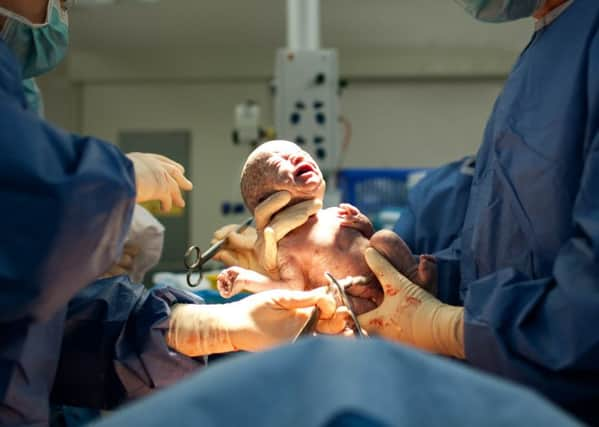Lori Anderson: Risks grow for unnatural births


WHEN it comes to giving birth, sisters have been doing it for themselves for millennia. Yet in recent centuries the hand of man has crept into the inner sanctum of the birthing room and not always with the most honourable of intensions. The reason a large majority of women now lie on their backs to give birth in western Europe, and no longer strain standing or on all fours, was originally down to the perverse curiosity of the Sun King Louis XIV of France. The foppish, beribboned monarch wished to watch as his mistress gave birth and so instructed her doctor to lie her down while he hid behind a screen. What started in the late 18th century as a mere aid to regal voyeurism was picked up by doctors who favoured a more convenient view as well as the ladies of French society who were anxious to adopt the latest most fashionable point on which to labour.
The oldest, most life-affirming act is evolving. Something is up in Scotland’s maternity wards and it’s not just the heart rates of anxious mothers-to-be.
Advertisement
Hide AdAdvertisement
Hide AdLast weekend it was revealed that Scotland now has one of the highest rates of Caesarean sections in the world. According to the World Health Organisation, a C-section, where the baby is cut out from the mother’s abdomen, should only be performed as a medical necessity and such circumstances usually arise in only 15 per cent of all births.
In April the Princess Royal Maternity in Glasgow recorded the highest C-section rate in Scotland, with 41 per cent of all babies born in this manner, while the average for NHS Greater Glasgow & Clyde, Scotland’s biggest health board, was 39 per cent.
One possible reason for the increase is that the University of Edinburgh is organising a trial in nine hospitals across Scotland, including the Princess Royal Maternity, for a new programme called Affirm which is designed to reduce the number of still births in Scotland. Under the system, pregnant women are advised to monitor the movements of their child and report any reduction to hospital staff so that possible problem pregnancies can be identified early.
While Professor Jane Norma, who is leading the study, said that she would be surprised in Affirm had increased the rate of C-sections, the national officer for the Royal College of Midwives, Emma Currer, said that, according to her members, there was a perception that Affirm was triggering the increase. Future research will reveal if there is indeed a connection but what is clear is that such a rise in C-sections is a cause for concern, as the death rate, though small, is still three times higher for a Caesarean section than a vaginal birth.
This week Gillian Smith, the Scottish director of the Royal College of Midwives said: “There is no doubt that there are concerns that the Caesarean section rate is rising. If the rate is increasing we need to know what this can be attributed to. We need to know if it is because of a policy change or something else.
“What we must be cautious of is not starting a cascade of unrequired interventions. A Caesarean is a major abdominal operation that carries risks for mothers and babies.”
Ms Smith’s warning against a “cascade of unrequired interventions” chimes with a new book published this week by the French doctor Michel Odent, who pioneered the birthing pool.
She may arch an eyebrow at the title – Do We Need Midwives? – but Odent’s point is that childbirth in western nations has become so overtly medicalised, with the introduction of surgery, drugs and chemicals, that the long-term consequences could be a generation of women who are unable to give birth without medical assistance. Odent calls for midwives to be “protectors of the evolutionary process” and so shield their patients from impatient doctors with itchy rubber-gloved hands anxious to intervene.
Advertisement
Hide AdAdvertisement
Hide AdWomen today spend, on average, two and a half hours more in labour than their mothers or grandmothers did in the 1960s.
The study in 2002 by the National Institute of Health, which analysed 40,000 births, believed it was caused by a change in delivery room practices ,among them the introduction of epidural anaesthesia which was used in only 5 per cent of births in the 1950s and 50 per cent today. The report also pointed to the use of synthetic oxytocin. Among the many properties of oxytocin, the so-called “love drug” which naturally occurs in our bodies, is that it helps to triggers labour and Dr Odent believes that the increase in synthetic oxytocin being administered to pregnant women is resulting in a decline in a woman’s ability to produce oxytocin.
“I believe that the human oxytocin system – oxytocin being the hormone of love fundamental to birth and bonding – even in adulthood is growing weaker,” she said. “The future of the human capacity to give birth is at risk.”
It may sound ridiculous but there are many who believe that the good doctor has a point. Soo Downe, Professor of Midwifery Studies at the University of Central Lancashire, said this week: “Odent has in the past said things that seem preposterous but a few years later are born out by the evidence. Giving women synthetic oxytocin interferes with the balance of hormones. Evidence is growing that there are long-term consequences.”
We’ve come a long way from the days when Queen Victoria’s use of chloroform as an early anaesthesia so angered the Church of England’s senior bishops, who – all male of course – considered labour pains to be God’s will. We will never return to a time when women routinely made a will upon discovering that they were pregnant, but there is clearly growing evidence, and rising concern among midwives, that we need to strike a better balance.